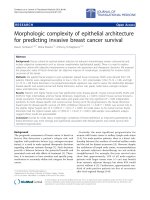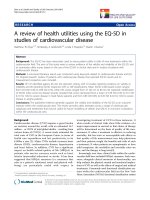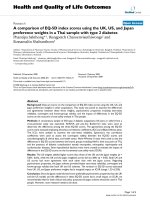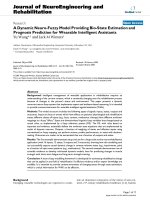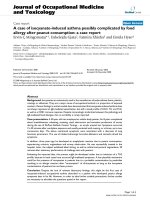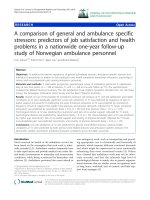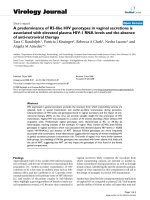báo cáo hóa học:" A survey of orthopaedic journal editors determining the criteria of manuscript selection for publication" pot
Bạn đang xem bản rút gọn của tài liệu. Xem và tải ngay bản đầy đủ của tài liệu tại đây (356 KB, 6 trang )
RESEARCH ARTICLE Open Access
A survey of orthopaedic journal editors
determining the criteria of manuscript selection
for publication
Caroline B Hing
1*
, Deborah Higgs
2†
, Lee Hooper
3†
, Simon T Donell
4†
and Fujian Song
3†
Abstract
Background: To investigate the characteristics of editors and criteria use d by orthopaedic journal editors in
assessing submitted manuscripts.
Methods: Between 2008 to 2009 all 70 editors of Medline listed orthopaedic journals were approached
prospectively with a questionnaire to determine the criteria used in assessing manuscripts for publication.
Results: There was a 42% response rate. There was 1 female editor and the rest were male with 57% greater than
60 years of age. 67% of the editors worked in university teaching hospitals and 90% of publications were in
English.
The review process differed between journals with 59% using a review proforma, 52% reviewing an anonymised
manuscript, 76% using a routine statistical review and 59% of journals used 2 reviewers routi nely. In 89% of the
editors surveyed, the editor was able to overrule the final decision of the reviewers.
Important design factors considered for manuscript acceptance were that the study conclusions were justified
(80%), that the statistical analysis was appropriate (76%), that the findings could change practice (72%). The level of
evidence (70%) and type of study (62%) were deemed less important. When asked what factors were important in
the manuscript influencing acceptance, 73% cited an understandable manuscript, 53% cited a well written
manuscript and 50% a thorough literature review as very important factors.
Conclusions: The editorial and review process in orthopaedic journals uses different ap proaches. There may be a
risk of language bias among editors of orthopaedic journals with under-representation of non-English publica tions
in the orthopaedic literature.
Keywords: editor orthopaedic
Background
Clinicians in orthopaedic practice are increasingly the
subject of revalidation and are expected to be able to
critically appraise new innovations w ith evidence based
medicine the cornerstone of medical practice [1]. The
clinician relies o n published literature and conferences
to expand his knowledge base but there is little known
on the criteria used by journal editors in selecting
manuscripts for publication [2,3]. All clinicians exhibit
bias in some form with the ethical principal of ‘equi-
poise’ difficult to uphold during the review process [4,5].
There is little published in the or thopaedic literature
on the subject of publication bias. Okike et al investi-
gated the influence of non-scientific factors on the
acceptance for publication in the Journal of Bone and
Joint Surgery (American Volume) and found that manu-
scriptsweremorelikelytobeacceptediftheywere
from the United States or Canada, reported a conflict of
interest related to a non-profit entity or were authored
by an individual with 10 or more prior publications in
frequently cited orthopaedic journals [6]. Editors play a
vital role in the peer review process but little evidence
* Correspondence:
† Contributed equally
1
Department of Trauma & Orthopaedics, St George’s Hospital, Tooting, UK
Full list of author information is available at the end of the article
Hing et al. Journal of Orthopaedic Surgery and Research 2011, 6:19
/>© 2011 Hing et al; licensee BioMed Central Ltd. This is an Open Access article distributed under the terms of the Creative Commons
Attribution License ( which permits unrestricted use, distribution, and reproduction in
any medium, provided the original work is properly cited.
exists to support the quality of published research due
to the use of editorial peer review [7-9].
We developed a questionnaire to establish which fac-
tors influence an editor’ s decision to accept a manu-
script and the criteria used in each journal’sreview
process.
Methods
A Medline search was used to identify all English and
non-English language orthopaedic journals that were
listed on Index Medicus in 2008. Seventy journals were
identified and approached between December 2008 and
March 2009 with a questionnaire in English via an email
link or by post if no email address was listed for the
principal editor [see additional file 1]. The questionnaire
was designed in English as only 10% of journals were
not published in English (Czech, French, Spanish, Polish,
German and Italian). We anticipated that most of these
journal editors would either speak English as a second
language or have access to a translator. Non-respon-
dents were approached again 2 months later then 6
months later. The editors were informed that the survey
was confidential and that their responses would be
anonymised.
The questionnaire design was based on a validated
questionnaire designed by Radford et al to determine
the criteria used by dental journals in assessing manu-
scripts [2]. A set of additional questions were used to
determine the demo graphics of the editors questioned
and the journals they represented. The additional ques-
tions included questions on age, gender, qualifications,
primary institution of work and c ountry of residence.
The questionnaire was designed to determine which fac-
tors in the stu dy, the manuscript and which aut hor
characteristics influenced an editor’s decision to accept
or reject a manuscript. Questions were also asked
regarding the review process and the journal character-
istics. If an editor represented more than one journal he
was sent a questionnaire specifically for each journal
that he edited. Each journals’ website was also examined
to determine the demographics of editors and journals
that had not responded. Journal impact factors for 2008
were also compiled from the Thomson Reuters Journal
Citation report published in 2009.
Responses were collected on an online database http://
www.surveymonkey.com (Portland, USA) and analysed
using Excel spreadsheets (Microsoft, Seattle, USA) and
SPSS version 11.5 (Chicago, Illinois). Statistical signifi-
cance was set at p < 0.05. The impact factor and lan-
guage of responders was compared to non-responders
using a Students t test. A post hoc analysis of error level
for completed surveys was also performed (survey sam-
ple random calculator, ).
Results
Thirty editors responded representing a 42% response
rate (error level 11.4%, 90% confidence intervals). One
American editor sent his respons e from France and one
sent his response from a different state. One editor
expressed an interest in feedback from the survey and
one editor noted he did not like the questions. The
mean impact factor for responding journal editors was
1.42 and for non-responders 1.53 which was not signifi-
cantly different (p = 0.67).
Ninety percent of editors of orthopaedic journals were
male, 1% female and 9% could not be determined.
Eighty-three percent of editors spoke English as a first
language. Fifty-seven percent of editors were over 60
year s of age with the remainder being 41 - 60 years old.
Sixty-seven percent worked in a University Hospital
with only 3% working in a district hospital. Seven per-
cent of editors had retired.
Analysis of the country of origin of publications
showed 50% of journals were published in the US, 40%
in the UK, 7% were from the East and 3% from Latin
America. Analysis of publishers showed that 23% of
orthopaedic journals are published by Elselvier, 18%
were independent, 17% by Springer-Verlag, 14% by
Lipincott, 6% by SLACK and 3% by Saunders, 3% SAGE
and the remaining 16% by othersmallerpublishers.
Thirty-seven percent of journals publish 12 issues per
year and 37% publish 6 issues per year. The remainder
varied from 4 to 10 issues per year.
Analysing the review process showed that 59% used a
review proforma, 52% anonymised manuscripts before
reviewing and 76% had a statistician routinely review all
studies. In 89% of journals the editor could over-rule
the reviewer’s final decision with 78% of referees allowed
to see each other’s reports. In 59% of journals 2 referees
routinely reviewed a manuscript with 35% of journals
using 3 referees routinely. Of th ose journals that anon-
ymised the manuscripts prior to peer review, 36% of edi-
tors could guess the authors or institutions in less than
10% of cases.
The editors’ opinio n regarding the most important
factors in a submitted study likely to influence a deci-
sion to accept a manuscript are summarised in table 1.
The most important factor likely to influence acceptance
was that t he study conclusions were justified (80%). An
appr opriate statistical analysis (76%), study findings that
could change practice (72%) and the level of evidence of
a study (70%) were also deemed important factors in the
study design. The editors surveyed felt that the most
important factors in the manuscript that influenced
acceptance were that the manusc ript was understand-
able (73%), well written (53%) and that the literature
review was thorough (50%), table 2.
Hing et al. Journal of Orthopaedic Surgery and Research 2011, 6:19
/>Page 2 of 6
When asked to rate what factors regarding the authors
most influenced an editor to accept a manuscript for
publication, 48% of editors regarded an author who cor-
rectly followed the instructions to authors as a slightly
important factor. They were indifferent t o how distin-
guished the senior author was (41%) or whether the
author was from a high quality institution (45%) and
rated knowledge of the authors or authors’ work as very
unimportant (45%).
Discussion
The ‘ gold stand ard’ editorial process defined by the
Cochrane Collaboration aims to produce studies that
are appropriate to the publication medium, important,
useful, original, methodologically sound, ethical and
accurate [10]. This is the first study to investigate
journal editor demogr aphics and the facto rs influencing
orthopaedic journal editors during the manuscript
review process. Evidence based medicine relies on the
journal review process to provide an unbiased represen-
tation of high quality studies [11]. Deleterious effects on
health policy and clinical decision s can result from pub-
lication and related biases. A recent Health Technology
Assessment found that studies with significant or posi-
tiveresultsweremorelikelytobepublishedandpub-
lished earlier than those with non-significant or negative
results [12]. Exclusion of non-English language studies
was a lso found to result in a high risk of bias in certain
research areas such as c omplementary and alternative
medicine [12].
The questionnaire used w as based on a previously
validated questionnaire designed by Radford et al [2].
Additional questions and a review of journal websites
and instructions to authors were used to provide addi-
tional information on journal demographics. The
response rate was 42% with no significant difference in
impact factor between responders and non-responders’
journal. Whilst the error level was 11.4% with 90% con-
fidence lim its, this is the first study of its kind and
represents an indication of journal editors’ preferences
for manuscript acceptance as well as their characteris-
tics which has not p reviously been documented in t he
literature. Poor response rates are a potential source o f
bias since the confidence with which the survey findings
can be accepted are a function of the achieved sample
size [13].
A small sample size resulting from poor response rates
exists if the responders differ from the non-responders
in terms of key characteristics [13]. A comparison of
impact factor between responders and non-responders
showed no significant difference with p = 0.67. However
comparison of language of publication showed 96% of
responders edited publica tions in English with only 76%
of non-responders editing publications in English (p =
0.03). This may indicated that non-response was due to
an inability to interpret the questionnaire which was in
English. This is a weakness in the study design indicat-
ing that the results may be subject to language bias.
Analysis of the demographics of orthopaedic journal
editors showed that 90% were male. Gender bias in
terms of editors, reviewers and authors has been studied
in the literature. Gilbert et al retrospectively reviewed
1851 research articles submitted to JAMA in 1991 and
found no bias based on reviewers’ or editors’ gender on
the decision to accept or reject a manuscript [14]. A
further study conducted by Caelleigh et al of 50 female
and 50 male reviewers showed no bias when assessing
an empirical study with two versions, one at tributing a
lower income i n women to gender issues and the other
attributing it to social learning factors [12,15]. However,
Table 1 Ranked design factors that influenced an editor’s
decision to accept a study for publication.
Study design factors Percentage score (very
unimportant/slightly unimportant/
indifferent/slightly important/very
important)
The study conclusions are
justified
80% very important
The statistical analysis is
appropriate
76% very important
The study findings could
change practice
72% very important
The level of evidence 70% very important
The study design (e.g.
randomised controlled trial)
62% very important
The study is a ‘hot topic 53% slightly important
The study complies with the
journal’s aim
48% very important
The study has a large sample
size
45% slightly important
The study reinforces my beliefs 41% very unimportant
The study findings are
unexpected
39% slightly important
The study findings are
statistically significant
38% very important
Table 2 Ranked manuscript factors that influenced an
editor’s decision to accet a study for publication.
Manuscript design factors Percentage score (very unimportant/
slightly unimportant/indifferent/
slightly important/very important)
The manuscript is
understandable
73% very important
The manuscript is well written 53% very important
The literature review is
thorough
50% very important
The references include papers
from my journal
40% indifferent
There is no financial conflict
of interest
37% slightly important
Hing et al. Journal of Orthopaedic Surgery and Research 2011, 6:19
/>Page 3 of 6
other studies have confirmed the presence of gender
bias in the publication process [16,17]. A Scandinavian
study used a sham paper with either male or female
authors to assess gender bias in a 1637 randomly
selected Swedish physicians. Female authors were
ranked higher than male authors. Male assessors were
found to reflect no gender bias but female assessors
upgraded female authors more than male authors [18].
A study of grant proposals has also shown gender bias
to the detriment of female applicants [19].
Eighty-three percent of editors spoke English as a first
language with 50% of journals published in the US and
40% in the UK. Geographical bias has been shown to
influence publication. A recent study of non-scientific
factors influencing acceptance of manuscripts to the
American Journal of Bone and Joint Surgery showed that
manuscripts submitted from countries other than the US
or Canada were significantlylesslikelytobeaccepted
(odds ratio 0.51, 95% confidence interval, 0.28 to 0.92; p
= 0.026) [7]. A Scandinavian study sent a methodologi-
cally flawed sham study in English and Scandinavian ver-
sions to 180 Scandinavian reviewers. The reviewers
considered the English version significantly better than
the Scandinavian version (p < 0.05) [20].
Fifty-seven percent of editors were over 60 years of
age w ith the remainder being 41-60 years of age. Seven
percent of editors had retired. D ata were not collected
on editorial experience. On searching Medline there is
no published study in the literature investigating the
effect of editor’s age on the quality of peer review and
this is an area that would benefit from further study . A
study of the natura l history of peer reviewers has found
that the majority of peer reviewers deteriorated over
time at a gradual rate but it is unclear whether this can
be extrapolated to editors [21].
Analysis of publishers showed that 23% of or thopaedic
journals are published by Elsevier, 18% were independently
published and 14% published by Lipincott. The effect of
publishers on the editorial process is unknown and
deserves further study as only 18% of orthopaedic journals
are published independently. A previous survey of editorial
independence at medi cal journals owned by professional
associations showed that 70% of editors reported having
complete or near complete editorial freedom, although
many received modest pressure from their owners over
editorial content. Forty-eight percent of journal’s board of
directors surveyed could hire and 55% could fire the editor
indicating that editors may not be entirely independent
from the influence of publishers [22].
Publishers can influence the speed of publication of a
manuscript according to t he system of review. The
introduction of online systems for peer review is seen as
advantageous by authors and editors rather than
reviewers [23]. Some publishers provide support to
reviewerswithonlinewebsitesandsurveystoimprove
knowledge and quality of the peer review process which
may in turn improve the quality of publications [24].
Our study showed that 59% of journals used a review
proforma, with 52% anonymising manuscripts and 76%
using a statistician to routinely review all studies. Jeffer-
son et al studied the effect of guidelines on peer review
at the BMJ and Lancet and found there was no impact
of guidelines on the quality of submissions but they did
help editors manage submissions [25]. Gardner et al
investigated the statistical assessment of manuscripts
submitted to the BMJ using a checklist and found the
statistical quality of the papers improved during the
peer review process [26]. Seventy-six percent of sur-
veyed orthopaedic editors ranked a ppropriate statistical
analysis as very important when deciding to accept a
paper yet only 76% had a statistician routinely review
papers. Previous studies have shown that a routine sta-
tistical review can improve the quality of methodology
of studies [27]. The use of a statistical che cklist may
therefore be beneficial in improving the quality of
papers during the review process in journals without a
routine statistical review.
Blinding of reviewers and editors has been extensively
investigated in the literature with conflicting results.
Some studies have shown blinding improves the quality
of reviews and provides more consistent results [28-30].
More recent studies have shown that blinding of
reviewers makes no difference to the quality of reviews
although there is a significant increase in reviewers
refusing to give their opinions [31-33] . Furthermore the
process of blinding is not infallible with reviewers able
to guess the identity of authors in small highly specia-
lised areas of study and those authors who self cite [34].
Our study showed that 36% of editors could guess the
authororinstitutioninlessthan10%ofsubmitted
anonymised manuscripts.
Our study found that in 59% of orthopaedic journals 2
referees were routinely used with 35% using 3 referees
routinely. This is consistent with the review process of
other biomedical journals with the majority using 2
reviewers and seeking the opinion of a third reviewer if
the 2 review ers contradicted each other or if a revie w
was significantly delayed [23].
In 89% of orthopaedic journals surveyed the editor could
over-rule the reviewer’ s final decision. Little is known
about the editorial review process with previous surveys of
editors of biomedical journals finding great diversity in
editorial policy and procedures [35]. Recent studies of the
editorial decisio n process hav e shown conflicting results.
A study in the Netherlands found that individual editor’s
decisions were far from consistent with individual editor’s
decisions complying poorly to team decisions, editor’srat-
ings not predicting reviewers’ ratings and editor’sratings
Hing et al. Journal of Orthopaedic Surgery and Research 2011, 6:19
/>Page 4 of 6
poorly predicting future citation [36]. A study from the US
of editors at Obstetrics and Gynaecology was more
encouraging with editors found to accurately assess the
quality of manuscripts [37]. Early editorial screening of
manuscripts without peer review can however decrease
the time to publication and reduces the workload of peer
reviewers without an effect on the quality of accepted
manuscripts [38].
When orthopaedic journal editors were surveyed, the
most important factors for accepta nce of a manuscript
were: justified study conclusions, appropriate statistical
analysis, study f indings that could change practice, an
understandable and well written manuscript and that
the instructions to authors were correctl y followed. Stu-
dies of editors of biomedical journals have shown that
manuscripts are more likely to be rejected if the topic
lacks originality, is not suited to the journal’s readership,
has weak methodological quality and lacks impact to
change current clinical practice [2,35]. Poor use of Eng-
lish is also cited as a reason for rejection [2]. Our study
found no evid ence of studies with positive results bei ng
more likely to be accepted for publication over those
with negative or non-significant results which is in
agreement with the current literature [39]. A study of
editorialmeetingsatJAMAshowedthatclarityofa
manuscript and response to referees’ comments as well
as journalism goals such as importance to medicine and
strategic emphasis for the journal were also important
in ensuring acceptance [40].
Conclusions
This study represents the first to survey orthopaedic
journal editors for their views on manuscript acceptance
and the demographics of editors. Whilst the response
rate was 42%, there was no significant difference in
impact factor betw een responders and non-responders.
Reasons cited by editors for manuscript acceptance are
similar to those of other biomedical journals. Editor
demographics indicate that most are male, ove r 40 years
of age and speak English. There is an over-representa-
tion of UK and US based publications in the literature
which increases the risk of language bias in the ortho-
paedic literature since poor English is cited as a reason
to reject a manuscript and deserves further study.
Additional material
Additional file 1: Survey Questionnaire. The data provided represents
the survey questionnaire
Author details
1
Department of Trauma & Orthopaedics, St George’s Hospital, Tooting, UK.
2
Royal National Orthopaedic Hospital, Stanmore, UK.
3
School of Medicine,
Health Policy & Practice, University of East Anglia, Norwich, UK.
4
Institute of
Orthopaedics, Norfolk & Norwich University Hospital, Norwich, UK.
Authors’ contributions
LH, FS and STD contributed to the study design. DH and CBH designed the
questionnaire. CBH analysed the data and wrote the manuscript. All authors
contributed to the manuscript.
Competing interests
The authors declare that they have no competing interests.
Received: 6 December 2010 Accepted: 28 April 2011
Published: 28 April 2011
References
1. Poolman RW, Kerkhoffs GM, Struijis PAA, Bhandari M: Don’t be misled by
the orthopaedic literature. Tips for critical appraisal. Acta Orthopaedica
2007, 78(2):162-171.
2. Radford DR, Smillie L, Wilson RF, Grace AM: The criteria used by editors of
scientific dental journals in the assessment of manuscripts submitted for
publication. British Dental Journal 1999, 187(7):376-379.
3. Senturia SD: How to avoid the reviewer’s axe: one editor’s view. IEEE
transactions on ultrasonics, ferroelectrics, and frequency control 2004,
51(1):127-130.
4. Fries JF, Krishnan E: Equipoise, design bias, and randomised controlled
trials: the elusive ethics of new drug development. Arthritis Res & Ther
2004, 6:R250-255.
5. Cain DM, Detsky AS: Everyone’s a little bit biased (even physicians). JAMA
2008, 299(24):2893-2895.
6. Okike K, Kocher MS, Mehlmn CT, Heckman JD, Bhandari M: Nonscientific
factors associated with acceptance for publication in the Journal of Bone
and Joint Surgery (American Volume). J Bone Jt Surg 2008, 90:2432-7.
7. Jefferson T, Alderson P, Wager E, Davidoff F: Effects of editorial peer
review. A systematic review. JAMA 2002, 287(21):2784-2786.
8. Purcell GP, Donovan SL, Davidoff F: Changes to manuscripts during the
editorial process. JAMA 1998, 280(3):227-228.
9. Jefferson T, Rudin M, Brodney Folse S, Davidoff F: Little evidence to
support the use of editorial peer review to ensure quality of published
research. Evidence Based Dentistry 2007, 8(3):88-89.
10. Jefferson T, Rudin M, brodney Folse S, Davidoff F: Editorial peer review for
improving the qulity of reports of biomedical studies (Review). The
Cochrane Library 2008, 4:5.
11. Begg CB, Berlin JA: Publication bias; a problem in interpreting medical
data. J Roy Stat Soc A 1988, 151:445-63.
12. Song F, Parekh S, Hooper L, Loke YK, Ryder J, Sutton AJ, Hing CB, Kwok CS,
Pang C, Harvey I: Dissemination and publication of research findings: an
updated review of related biases. Health Technology Assessment 2010,
14(8):iii.
13. McColl E, Jacoby A, Thomas L, Soutter J, Bamford C, Steen N, Thomas R,
Harvey E, Garratt A, Bond J: Design and use of questionnaires: a review of
best practice applicable to surveys of health service staff and patients.
Health Technology Assessment 2001, 5(31):101.
14. Gilbert JR, Williams ES, Lundberg GD:
Is there gender bias in JAMA’s
peer
review process? Journal of the American Medical Association 1994,
272:139-142.
15. Caelleigh AS, Hojat M, Steinecke A, Gonnella JS: Effects of reviewers’
gender on assessments of a gender-related standardized manuscript.
4th International Congress on Peer Review in Biomedical Publication, 14-16th
September 2001, Barcelona, Spain .
16. Eagerly AH: The science and politics of comparing women and men.
American Psychologist 1995, 50:145-158.
17. Riger S: Epistemological debates, feminist voices: Science, social values,
and the study of women. American Psychologist 1992, 47:730-740.
18. Johansson EE, Risberg G, Hamberg K, Westman G: Gender bias in female
physician assessments. Women considered better suited for qualitative
research. Scand J Prim Health Care 2002, 20:79-84.
19. Wenneras C, Wold A: Nepotism and sexism in peer-review. Nature 1997,
387:341-343.
20. Nylenna M, Riis P, Karlsson Y: Multiple blinded reviews of the same two
manuscripts. Effects of referee characteristics and publication language.
JAMA 1994, 272:149-51.
Hing et al. Journal of Orthopaedic Surgery and Research 2011, 6:19
/>Page 5 of 6
21. Callahan M: The natural history of peer reviewers: the decay of quality.
The 6th International Conference on Peer Review and Biomedical Publication,
September 10-12, Vancouver, Canada .
22. Davis RM, Mullner M: Editorial independence at medical journals owned
by professional associations: a survey of editors. Sci Eng Ethics 2002,
8:513-28.
23. Mulligan A: Is peer review in crisis? Oral Oncology 2005, 41:135-141.
24. Mulligan A: Peer review survey 2009: preliminary findings.,
Senseaboutscience.org.uk.
25. Jefferson T, Smith R, Yee Y, Drummond M, Prat M, Gale R: Evaluating the
BMJ guidelines for economic submissions: prospective audit of
economic submissions to BMJ and The Lancet. JAMA 1998, 280(3):275-7.
26. Gardner MJ, Bond J: An exploratory study of statistical assessment of
papers published in the British Medical Journal. JAMA 1990,
263(10):1355-7.
27. Day FC, Schriger DL, Todd C, Wears RL: The use of dedicated
methodology and statistical reviewers for peer review: a content
analysis of comments to authors made by methodology and regular
reviewers. Annals of Emergency medicine 2002, 40(3):329-33.
28. McNutt RA, Evans AT, Fletcher RH, Fletcher SW: The effects of blinding on
the quality of peer review. JAMA 1990, 263(10):1371-6.
29. Fisher M, Freidman SB, Strauss B: The effects of blinding on acceptance of
research papers by peer review. JAMA 1994, 272:143-6.
30. Jadad AR, Moore A, Carroll D, Jenkinson C, Reynolds DJM, Gavaghan DJ,
McQuay HJ: Assessing the quality of reports of randomised clinical trials:
is blinding necessary? Controlled Clinical Trials 1996, 17:1-12.
31. Van Rooyen S, Godlee F, Evans S, Black N, Smith R: Effect of open peer
review on quality of reviews and on reviewers’ recommendations: a
randomised trial. BMJ 1999, 318:23-7.
32. Godlee F, Gale CR, Martyn CN: Effect on the quality of peer review of
blinding peer reviewers and asking them to sign their reports. JAMA
1998, 280(3):237-40.
33. Walsh E, Rooney M, Appleby L, Wilkinson G: Open peer review: a
randomised controlled trial. British Journal of Psychiatry 2000, 176:47-51.
34. Justice AC, Cho MK, Winker MA: Does masking author identity improve
peer review quality. JAMA 1998, 280:240-2.
35. Lee K, Boyd E, Bero L: A look inside the black box: a description of the
editorial process at the three leading biomedical journals [abstract].
12th
Cochrane Colloquium, 2-6 October 2004; Ottawa, Canada .
36. Opthof T, Coronel R: Consistency of decision making by editors: the
relation between reviewers’ and editors’ ratings and future (10 years)
citation. The 6th International Conference on Peer Review and Biomedical
Publication, September 10-12, Vancouver, Canada .
37. Logothetti H, Martin S, Benner R, Scott J, Queenan J, Spong C: Evaluation
of editors’ judgement on quality of articles. The 6th International
Conference on Peer Review and Biomedical Publication, September 10-12,
Vancouver, Canada .
38. Claiborne Johnston S, Lowenstein DH, Ferriero DM, Messing RO,
Oksenberg JR, Hauser SL: Early editorial manuscript screening versus
obligate peer review: a randomised trial. Ann Neurol 2007, 61:A10-A12.
39. Olson CM, Rennie D, Cook D, Dickersin K, Flanagin A, Hogan JW, Zhu Q,
Reiling J, Pace B: Publication bias in editorial decision making. JAMA 2002,
287(21):2825.
40. Dickersin K, Ssemanda E, Mansell C, Rennie D: What do the JAMA editors
say when they discuss manuscripts that they are considering for
publication? Developing a schema for classifying the content of editorial
discussion. BMC Medical Methodology 2007, 7:44.
doi:10.1186/1749-799X-6-19
Cite this article as: Hing et al.: A survey of orthopaedic journal editors
determining the criteria of manuscript selection for publication. Journal
of Orthopaedic Surgery and Research 2011 6:19.
Submit your next manuscript to BioMed Central
and take full advantage of:
• Convenient online submission
• Thorough peer review
• No space constraints or color figure charges
• Immediate publication on acceptance
• Inclusion in PubMed, CAS, Scopus and Google Scholar
• Research which is freely available for redistribution
Submit your manuscript at
www.biomedcentral.com/submit
Hing et al. Journal of Orthopaedic Surgery and Research 2011, 6:19
/>Page 6 of 6

